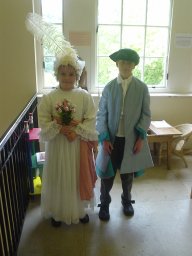Art and Design at Key Stage 1 and Key Stage 2

Let’s Face It workshop 2006.
Children at Key Stage 2 dressing up for their peers to draw, involving discussions on pose, expression, accessories and dress, here based on portraits of Henrietta Laura Pulteney (a local character) by Angelica Kauffmann and Garton Orme by Jonathan Richardson.
© The Holburne Museum of Art
The main ways portraits can assist the curriculum is through:
- Exploring and developing ideas
- Investigating art and art materials
- Developing creativity
Key Stage 1
- Portraiture can be used as the basis for students to record from first-hand observation and explore ideas.
- The range of different mediums of a portrait collection can be used to investigate a range of materials and processes.
- A portraiture collection comprising different periods and cultures can be used as the basis for studying the differences and similarities of art in different times and cultures.
A good example: Let’s Face It!
The Holburne Museum of Art in Bath run an interactive workshop called, ‘Let’s Face It!’ that introduces children to portraits and portrait miniatures and how they express ideas about the people pictured.
Pupils take part in drawing, role-play and an in-depth creative activity to explore why portraits were commissioned. The use of expression, pose, costume, setting and social context are all considered. Students create their own self-portrait to take home.
Key Stage 2
- Portraiture can be used as the basis for students to question and make thoughtful observations, particularly with reference to self-portraiture and communicate ideas about themselves.
- The range of different mediums of a portrait collection can be used to investigate a range of materials and processes.
- Portraits can be used as the basis of discussion around observations of depicting people and looking at how relationships are portrayed.
- A portraiture collection comprising different periods and cultures can be used as the basis for studying the differences and similarities of art in different times and cultures.
- Visiting a museum, gallery or historic site to participate in a portrait workshop is an important part of Key Stage 2 (Unit 9 Visiting a museum, gallery or site)
